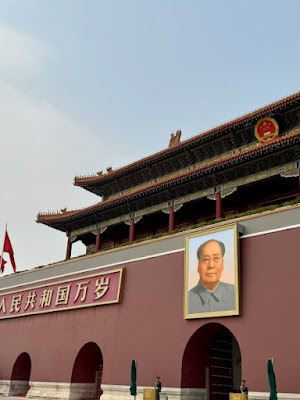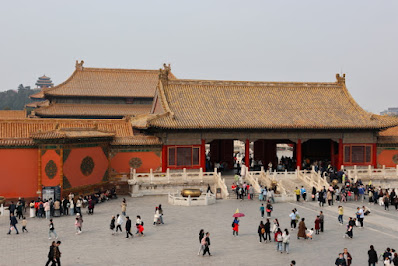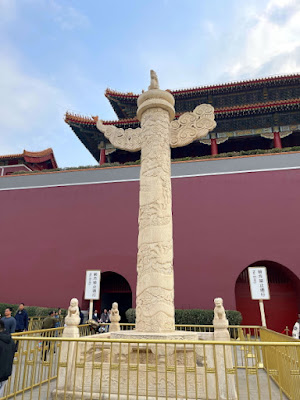 |
| Picture by Heather |
Tian'anmen Square and The Imperial Palace complex (Forbidden City) are located in the central part of Beijing, China.
During the Ming Dynasty in 1419, a city wall was constructed around The Imperial Palace complex and the main entrance to the south part of Tian'anmen Square was through Zhengyangmen ("Front Gate"). Zhengyangmen was aligned such that the city's central north-south axis passes directly through the center of the gate.
Originally, Zhengyangmen was part of a large barbican that consisted of an archery tower, gatehouse, and side walls with separate gates. Most of the City Wall and side gates were torn down in 1915, but Zhengyangmen was left standing and now houses the History of Beijing Museum.
 |
| Picture by Kolohe |
Fortunately, our guide Peter II knew how to work our way through the line of people waiting to visit the Tian'anmen Area and we did not have to wait for a long period of time.
 |
| Picture by Heather |
The National Museum of China is located on the east side of Tian'anmen Square and contains 48 exhibition halls with over 1.4 million items. It is the largest single-building museum in the world with a total construction area of 200,000 sq m (49 acres).
Located on the west side of Tian'anmen Square is The Great Hall of the People where the National People's Congress meets. In the middle of Tian'anmen Square is the Monument to the People's Heroes, which was constructed in 1958. The Monument is decorated with reliefs from China's revolutionary history.
 |
| Picture by Kolohe |
 |
| Picture by Kolohe |
Located on the north side of the Square is the Gate of Heaven Peace (also called Tian'anmen Gate) where Chairman Mao proclaimed the founding of the People's Republic of China on October 1, 1949. A large portrait of Chairman Mao still hangs over the entrance gate.
A stone column called "Huabiao" is located in front of the Tian'anmen gate and decorated with depictions of dragons and phoenixes. Along the gate's side walls facing Tian'anmen Square are fountains with continually changing water patterns.
 |
| Picture by Kolohe |
 |
| Picture by Kolohe |
 |
| Picture by Heather |
 |
| Picture by Kolohe |
On several occasions during our trip, young Chinese people came up and wanted their picture taken with Sophia. One group even wanted me in the picture!
 |
| Picture by Kolohe |
 |
| Picture by Heather |
The Imperial Palace (now known as "Forbidden City") was completed in 1420 and was the Emperor's official residence and center of political power until 1924. It is the world's largest preserved royal palace complex still standing and was declared a World Heritage Site in 1987.
Forbidden City is now part of The Palace Museum and one of the most popular tourist attractions in the world. Out-of-country visitors should be aware that China tour books are very confusing when describing the improvements at Forbidden City. Chinese characters can be translated several different ways, so different books give different names to the same buildings. Anyone visiting the area should do their own research using multiple sources.
The Palace Museum complex is much larger than what it appears to be in tourist books -- 720,000 sq m or 178 acres. Based on oral histories, at one time the The Imperial Palace had 9,999 rooms; but it is now believed that the room count was closer to 8,886.
Surrounding Forbidden City is a 52 m (171 ft) wide mote that is 6 m (20 ft) deep. On the interior side of the mote there is a 7.9 m (26 ft) high wall that is 8.62 m (28.3 ft) wide at the base, tapering to 6.66 m (21.9 ft) at the top. The wall was made with a rammed earth core, then surfaced with three layers of specially baked bricks.
To reach Forbidden City, we first had to pass through two perimeter walls before we could even reach the Forbidden City Meridian Gate.
The large steel doors at the wall openings were designed based on "the harmonious principle of yin and yang." Yang is represented by odd numbers and the preferred masculine element associated with the emperor. The number 9 is considered to be the ultimate odd number and 9 times 9 is especially fortunate, so each door contains 9 rows of 9 brass studs each.
After passing through the Gate of Heaven Peace, we could look back through the gate and see the Monument to the People's Heroes in Tian'anmen Square.
The next gate we had to pass through was called Duanmen, also known as the Gate of Uprightness.
 |
| Picture by Heather |
 |
| Picture by Heather |
 |
| Picture by Heather |
 |
| Picture by Heather |
 |
| Picture by Heather |
After passing through the Gate of Uprightness, we arrived at the outside wall surrounding Forbidden City. Peter II informed us that this was as far as we could go without additional tickets, and same-day tickets were not available for the Forbidden City Outer and Inner Courts. Heather and Kolohe decided to talk to the ticket office people and to Perter II's surprise, they came back with same-day tickets. It turned out that Peter II's tour company manager happened to be standing by the ticket office and she said that she had been doing Forbidden City tours for 20 years and that was the first time she ever witnessed someone getting same-day tickets by walking up to the ticket window.
To reach the Forbidden City Outer and Inner Courts, we first had to pass through the Meridian Gate.
Meridian Gate has protruding arms on each side of the gate, which were used to decorate the main entrance. It was from the balcony of Meridian Gate that the emperor would stand to review his armies and where each year he would stand to perform a ceremony making the start of a new calendar.
Only the Emperor could use the gate's center entrance, with exception of the Empress who could enter it once on the day of her wedding; and the top three scholars of the triennial civil service examinations who could exit the gate after completing the examination. We were allowed to walk through the center gate.
 |
| Picture by Kolohe |
 |
| Picture by Heather |
 |
| Picture by Kolohe |
After passing through Meridian Gate, we entered the first part of the Outer Court ("Front Court") that was used by the emperor to host ceremonies and rituals. The Golden Water River meanders through the courtyard and is crossed by five bridges.
 |
| Picture by Kolohe |
The courtyard is surrounded by various buildings and on the north side of the courtyard is The Gate of Supreme Harmony.
The Gate of Supreme Harmony passes through a 24 m(78 ft) high double-eaved building that was originally used to receive visitors, but during the Qing Dynasty the building was used as a banquet hall. A pair of Chinese Lions guard the building's entrance and on the roof there are nine guardians that are associated with water to protect the building from fire.
 |
| Picture by Kolohe |
 |
| Picture by Koloke |
 |
| Picture by Kolohe |
 |
| Picture by Kolohe |
 |
| Picture by Heather |
 |
| Picture by Peter II |
After passing through the Gate of Supreme Harmony, the Hall of Supreme Harmony is located at the north end of another large courtyard. This hall, and two other halls, are located on a three-tired platform. There is a large central marble ramp leading up to the halls that could only be used by the emperor. The Hall of Supreme Harmony is the largest hall in the palace and was used for major occasions such as the enthronement of a new emperor.
 |
| Picture by Heather |
 |
| Picture by Kolohe |
 |
| Picture by Kolohe |
Located north of the Hall of Supreme Harmony on the same three-tiered platform are the Hall of Middle Harmony that was used to receive the emperor before official ceremonies and the the Hall of Preserving Harmony that was used for rehearsing ceremonies and administering the final stage of Imperial examinations. An Imperial examination was used for selecting candidates for civil service jobs. Parts of the Imperial examination are still used today for selecting Chinese civil service candidates.
Passage from the Outer Court to the Inner Court is through the Gate of Heavenly Purity. The Inner Court was the home of the Emperor and his family and where the Emperor spent most of his time. The Emperor only visited the Outer Court for ceremonial purposes. After passing through the Gate of Heavenly Purity, the elevated path leads to the Palace of Heavenly Purity. Various artifacts were on display in the Palace
 |
| Picture by Kolohe |
 |
| Picture by Kolohe |
 |
| Picture by Kolohe |
 |
| Picture by Kolohe |
 |
| Picture by Kolohe |
 |
| Picture by Kolohe |
 |
| Picture by Heather |
We exited through the Gate of Divine Might, crossed the mote, and our driver was waiting for us on the street.
 |
| Picture by Kolohe |























































No comments:
Post a Comment